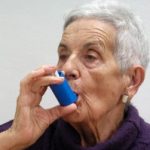Respiratory diseases like asthma, COPD and bronchitis can be troublesome in the winter season as the colder air can make it much more difficult to manage these diseases. Asthma in the winter can trigger asthma attacks and seasonal allergies. The cold winter air can be an asthmatic’s worst nightmare as it makes it far more difficult to breathe. Generally, asthma attacks increase during the winter months, not solely because of cold air, but because individuals spend more time inside, which can expose them to dust and mold.
Here are a round-up of Bel Marra Health’s articles discussing how to reduce your risk of asthma, COPD, shingles and bronchitis to help ensure you enjoy the winter season and not dread it.
Gut bacteria deficit linked to higher asthma risk
Advertisement
 Scientists have known for a long time that gut bacteria plays an important role in our digestive health; however, now there is more evidence that it influences many different aspects of our well-being, including our asthma risk.
Scientists have known for a long time that gut bacteria plays an important role in our digestive health; however, now there is more evidence that it influences many different aspects of our well-being, including our asthma risk.
Although many differ, we all have a core set of microorganisms in common. Gut bacteria, or microorganisms, are called microbiota, while all genes of microbiota are referred to as microbiome. The genes of the microbiome outnumber the genes of the human body by about 150-fold; it’s no wonder that the gut has such an influence on our overall health.
The majority of research conducted on gut bacteria shows that people who suffer from diseases such as inflammatory bowel, irritable bowel and allergies have microbiota that are different to that of healthy people. They have not been able to say for certain if the gut make-up is the cause of the disease or if it changes as a result of the disease. Some of the latest research in this area suggests that a lack of certain gut bacteria in the first three months after birth may put babies at a higher risk for asthma. Continue reading…
Scientists discover link between Shingles and Asthma
 According to a new study, the risk of developing the painful skin condition shingles, is higher in people suffering with asthma than it is in non-asthmatic people.
According to a new study, the risk of developing the painful skin condition shingles, is higher in people suffering with asthma than it is in non-asthmatic people.
The findings of the new study build on previous studies which suggest a link between the risk of shingles and asthma.
Nearly 1 million Americans, especially older adults get affected by shingles every year.
According to Dr. Young Juhn, an asthma epidemiologist at the Mayo Clinic Children’s Research Center in Rochester, and the author of the new study, “Asthma represents one of the five most burdensome chronic diseases in the U.S., affecting up to 17 percent of the population.” Continue reading…
30 minutes a day of exercise improves asthma symptoms
 Research from Concordia University in Montreal unveiled that 30 minutes a day of exercise can improve asthma symptoms. Millions of individuals suffer from asthma, and reports show many of them do not have proper control of it. Daily, year-round exercise can offer better control of symptoms for asthma sufferers.
Research from Concordia University in Montreal unveiled that 30 minutes a day of exercise can improve asthma symptoms. Millions of individuals suffer from asthma, and reports show many of them do not have proper control of it. Daily, year-round exercise can offer better control of symptoms for asthma sufferers.
Asthma is a respiratory condition that makes it more difficult to breathe. There are many triggers, such as allergens, respiratory infections, air pollution, cold air, smoke, stress and certain medications. Unfortunately, there is no cure.
Researchers analyzed exercise habits of 643 asthma patients. Their results revealed that those who engaged in more physical activity were two and a half times more likely to have better control of their condition when compared to those who did not exercise. Continue reading…
Asthma, COPD and bronchitis: Key differences in common respiratory diseases
 Common respiratory diseases like asthma, bronchitis and COPD can seriously impact a person’s quality of life, but proper diagnosis and treatment can help those who suffer live more comfortably.
Common respiratory diseases like asthma, bronchitis and COPD can seriously impact a person’s quality of life, but proper diagnosis and treatment can help those who suffer live more comfortably.
Understanding the differences between asthma, COPD and bronchitis can help lead to appropriate care.
The differences between asthma and chronic obstructive pulmonary disease, or COPD, are often more clear once risk factors are examined. Risk factors for asthma are different from risk factors for COPD. With asthma the primary risk factors include allergens, such as dust, pets and mold.
Advertisement
Occupational factors are also associated with asthma. This could include dust or chemicals in the workplace. Some people with asthma also experience respiratory infections. When it comes to COPD, smoking is the biggest contributing factor. Occupational factors also exist, but it is normally strong chemicals entering the lungs that lead to the damage. Outdoor pollution and alcoholism are risk factors for COPD, too. Continue reading…
Dyspnea (shortness of breath) in asthma, COPD is important for diagnosis
 Dyspnea (shortness of breath) is found in asthma and COPD and is an important symptom for diagnosis. Shortness of breath severity can range from person to person, but is commonly described as tightening of the chest or feelings of suffocation. Shortness of breath can occur for many reasons, and is often a symptom of many other conditions. However, if it is tied with a respiratory disease like asthma or COPD, it can also be chronic.
Dyspnea (shortness of breath) is found in asthma and COPD and is an important symptom for diagnosis. Shortness of breath severity can range from person to person, but is commonly described as tightening of the chest or feelings of suffocation. Shortness of breath can occur for many reasons, and is often a symptom of many other conditions. However, if it is tied with a respiratory disease like asthma or COPD, it can also be chronic.
In a healthy individual, shortness of breath can occur from strenuous exercise, extreme temperatures, changes in altitude or even from obesity. If shortness of breath occurs suddenly it could be a sign of something more serious and medical attention should be sought right away. Continue reading…
